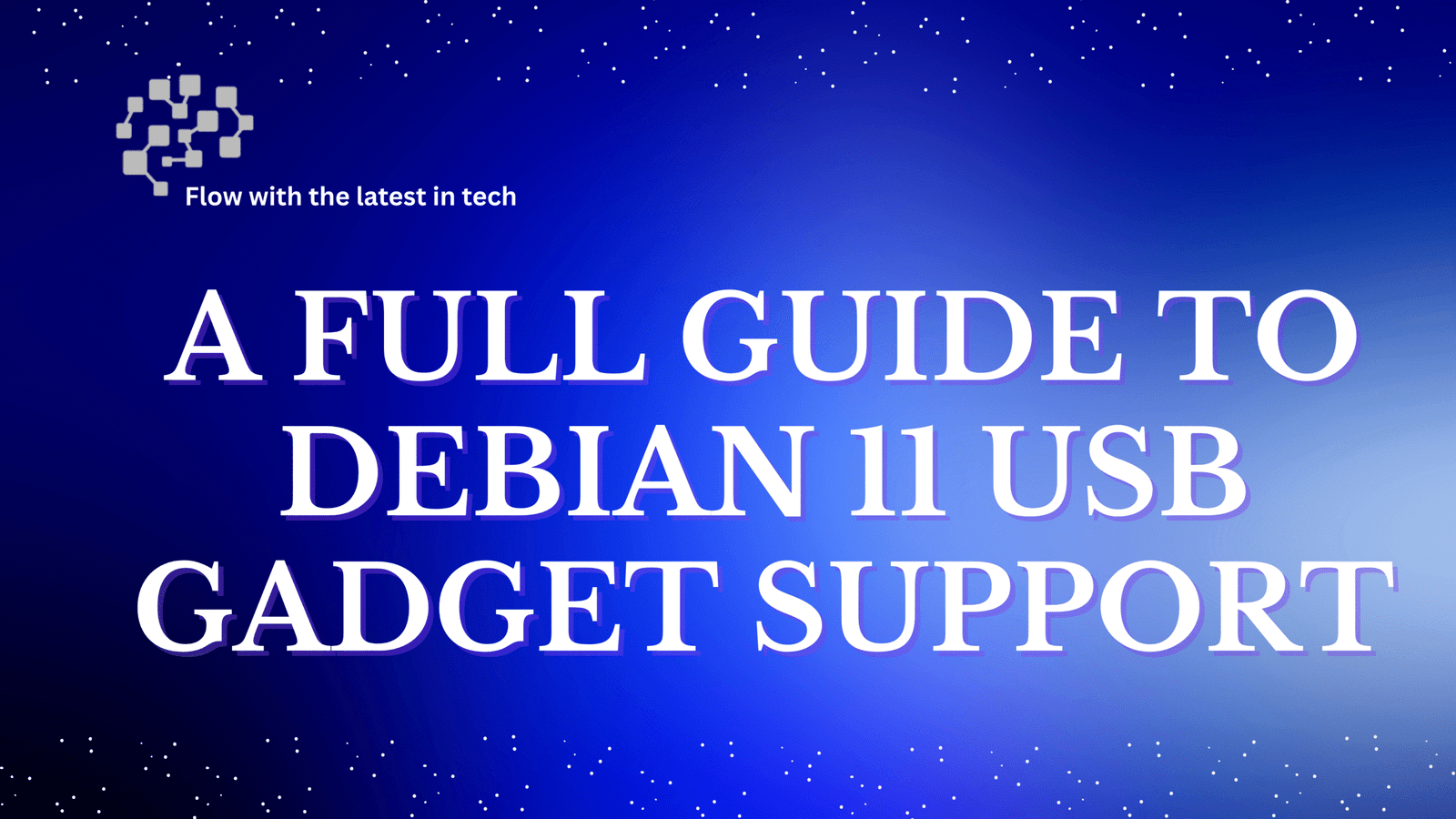Table of Contents
Introduction:
Linux has always been at the top when it comes to being flexible and coming up with new ideas. Debian is known for being stable safe and dependable among its various distributions. Debian 11 or “Bullseye” is in line with this legacy by supporting new technologies and giving developers system administrators and learners all across the world a place to start.
USB Gadget Support is one of the most interesting things in Debian 11. This capability lets some devices work as USB peripherals instead of only hosts. When you plug your Debian-powered device into another computer it can act like a USB flash drive keyboard mouse printer or even a network card.
This feature gives developers researchers teachers and amateurs new opportunities. It is very helpful for embedded systems IoT projects testing devices and labs for learning.
This blog gives a full picture of Debian 11 USB Gadget Support. We’ll talk about what it is why it matters how it works its advantages and downsides key factors real-world uses common queries and a clear conclusion.
What does Debian 11 USB Gadget Support do?
The computer is the host when you plug in a USB device like a flash drive or keyboard. The USB device is the gadget (peripheral). Your computer can’t usually be the gadget; it’s always the host.
But with Debian 11 USB Gadget enable some Debian devices (such Raspberry Pi Zero BeagleBone and other boards that enable USB OTG) can switch places. They can act like gadgets instead of being the host.
What kinds of USB gadgets work with Debian 11
Gadget for Mass Storage
It makes the device look like a USB flash drive.
Good for sending files to other computers.
Ethernet Gadget RNDIS CDC ECM
It makes the device look like a USB network adapter.
Lets the device and the host computer talk to each other over the network.
Gadget in a row
Makes the device look like a USB port for serial connection.
Good for getting into the console fixing problems and testing.
HID Gadget Human Interface Device
Lets the device work as a mouse keyboard or joystick.
Useful for projects that need automation or specific input.
MTP Gadget (Media Transfer Protocol)
Lets the device work as a media player.
Good for moving pictures music and videos.
Gadget Composite
A strong choice that lets you use many gadgets at once.
For example a device can be both a USB network adapter and a mass storage device at the same time.
What is the point of Debian 11 USB Gadget Support?
To understand how important USB Gadget Support is you can look at what modern technology needs:
Systems that are built in
People regularly use small boards like Raspberry Pi and BeagleBone in robotics the Internet of Things and smart devices.
USB gadget support makes it easy for them to talk to host PCs.
Saving Money
Debian can simulate USB serial devices and network adapters so you don’t have to buy them.
Testing and Making
Without having to acquire them developers may see how different USB devices work.
Education and Learning
Great for teaching how to use USB Linux kernel ideas and how to put systems together.
Support for Multiple Platforms
You can use Debian gadgets with Windows macOS and other Linux hosts.
Connecting from afar
Useful for working with headless devices (devices that don’t have a screen or keyboard). You can still, get to them over USB networking.
What is the Debian 11 USB Gadget Support?
Let’s, make it easier to comprehend how it works:
The USB Gadget Framework is a part of the Linux kernel.
This framework is turned on by, default in Debian 11.
Debian can load modules that transform the device into a USB gadget if it has the right hardware.
The host machine then sees the Debian device as a regular USB device.
To put it simply Debian takes over the USB port and tells the host computer “I am a keyboard” or “I am a flash drive” depending on what you want the gadget to do.
Benefits of Debian 11 USB Gadget Support
Versatility: It can act as a lot of different USB devices.
Cost-Effective: You don’t have to buy separate gadgets anymore.
Open Source: Users can fully customize the software.
Cross-Platform Compatibility means it works, with more than one operating system.
Scalable: good for people small projects and big businesses.
Value for Learning: It teaches, kids about the insides of USB.
Dynamic Configuration: It’s easy, to switch or combine gadgets.
Portability: One device can take the place of several USB accessories.
Great for developers because it gives, them a reliable place to test.
Helpful Community: Debian forums and Linux docs, can help you.
Debian 11 USB Gadget Support: The Bad
Difficult for Beginners—Needs, technical know-how.
Limitations on performance: It could not be as quick as, dedicated hardware.
Hardware Limitations: It only works on devices, that support USB OTG.
Problems, with compatibility: Some host, systems may need supplementary, drivers.
Security Risks: USB devices, can make your system more vulnerable if they aren’t set up correctly.
Needs to be updated to work, with latest, kernels.
Learning Curve: Not very easy for beginners.
Limited Use on Desktops/Laptops Mainly for boards not regular PCs.
Important Things to Think About Before Using Debian 11 USB Gadget Support
Kernel Support: Check that Debian’s, kernel has all the modules it needs.
Hardware: Make sure your device can use USB OTG On The Go.
Choose the type of device you require storage serial networking based on what you need it for.
Security: Set up carefully to avoid problems.
Expectations for Performance: Don’t count on it for fast transfers.
Ease of Use: You should be ready to invest time learning how to use it.
Composite Gadgets: Figure out if you need to do more than one thing at once.
Community Help: If you have a problem ask, for help in Debian forums, or Linux groups.
Long-Term Use: Check to see if your, device will still work with future versions of Debian.
Plan B: Always have a way, to go back if things goes wrong.
How to Use Debian 11 USB Gadget Support in the Real World
Creating things for the Internet of Things
Smart devices can act as network adapters to let computers talk to each other.
Sharing Data
You can use Debian devices like USB flash drives to move data safely and in a controlled way.
Keyboards and mice made just for you
You can make unique programmable input devices with HID gadgets.
Tools for Debugging
Serial gadgets let you keep an eye on and fix systems.
School
Great for teaching people how to use computers and their hardware.
Making prototypes of USB devices
Before making real hardware developers can test their ideas for USB devices.
Cybersecurity
Used for penetration testing to act as bad or unusual USB devices.
Devices for Health
During testing medical developers might use USB monitoring tools to see how they work.
Moving Media
Works as an MTP device to share music photos and videos.
Making connections
Lets headless boards connect by USB and get direct access to the network.
Questions and Answers
Q1: Is it possible for all devices to run Debian USB Gadget Support?
No. Only devices that enable USB OTG such as the Raspberry Pi Zero or BeagleBone can work as gadgets.
Q2: Is it possible to utilize it on a laptop or PC?
Not generally. Laptops that are standard do not work as devices.
Q3: Is it safe to use?
Yes but only if it is set up correctly.But don’t link to systems you don’t trust.
Q4: Do I need to install more software?
No. The gadget framework is already in Debian 11.
Q5: Can it take the place of real physical gadgets?
Yes, for a lot of things. But performance may not be the same as dedicated devices.
Q6: Will it work with Windows hosts?
Yes, although some devices like Ethernet may need drivers.
Q7: Is it helpful for people who are just starting out?
Yes but beginners should start with easy-to-use technologies like USB storage.
Q8: Can more than one device work at the same time?
Yes, composite electronics can do more than one thing.
Q9: Is it quick?
It works, but it’s not necessarily as quick as USB devices made for businesses.
Q10: Is Debian 11 the best distro for supporting gadgets?
It is one of the most stable. It can also work with other distros like Arch or Ubuntu.
In conclusion
Debian 11 USB Gadget Support is a very useful feature that lets you use Linux-powered boards as USB devices in many different ways. It lets developers teachers and hobbyists make their own gadgets act as USB peripherals and save money on extra hardware.
It is flexible works on many platforms and is cheap. Some of its problems include that it is hard to use doesn’t work well and needs special hardware. But if you know what you’re doing and put things, up well you can deal with these problems.
Debian 11 USB Gadget Support is not only an optional feature for people who work with IoT embedded devices or Linux testing; it is a tool that everyone should learn how to use. This feature will still be crucial for teaching development and real-world projects as technology progresses further.
As USB technologies, like USB C and USB4 become more common in 2025 and beyond knowing how to use Debian’s USB gadget support will help you stay ahead in the fields of Linux and embedded systems development.

